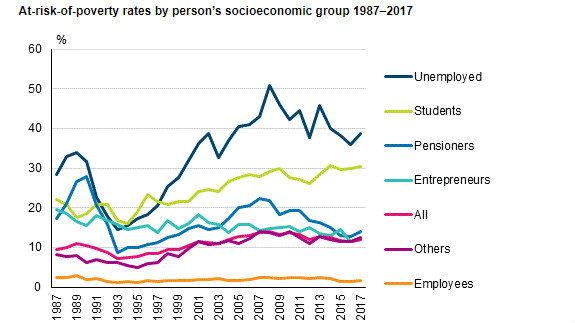Statistics Finland’s income distribution figures indicate that unemployed and students are most commonly at risk of poverty.
Of those having been unemployed for at least six months during the year, almost 39% were members of households at risk of poverty in 2017. Around 31 per cent of students were members of households at risk of poverty.
The at-risk-of-poverty rates between population groups have separated from each other during the 30-year review period, especially during the time after the recession in the 1990s. Employees are very rarely at risk of poverty, Statistics Finland remarks.

Source: Statistics Finland
The unemployed
Statistics Finland explains that the relative risk of poverty also varies within the population groups. Among unemployed persons there are differences between those who received earnings-related unemployment allowance and those who received unemployment benefits from the Social Insurance Institution.
Of the unemployed who received only earnings-related to unemployment allowance during the year, around 15 per cent were at risk of poverty in 2017. One-half of the unemployed who received only basic unemployment benefits from the Social Insurance Institution were at risk of poverty, as explained by the Finnish statistical office on its release.
Of those who during the year received both earnings-related unemployment allowance and basic unemployment benefits from the Social Insurance Institution, 38 per cent were members of households at risk of poverty. Over one-half of unemployed at risk of poverty have received basic daily allowance or labour market support and no earnings-related security at all.
Risk of poverty among pensioners
The risk of poverty among the 1.38 million pensioners also varies. Risk of poverty is rare among former salaried employees, who make up close on one-half of all pensioners. Among former lower-level employees, good eight per cent are at risk of poverty, but among former upper-level employees the number is extremely small.
Former farmers have the highest at-risk-of-poverty rate, around 38 per cent. The risk of poverty for those retired from worker occupations and retired entrepreneurs also exceeds the at-risk-of-poverty rate in the total population (12.1%). Around nine out of ten pensioners at risk of poverty receive part of their pension income from national pension and/or guarantee pension.
Structural changes can alter the at-risk-of-poverty rates of the population groups inversely in relation to expectations when the economic situation changes. For example, when the number of unemployed increases, persons who receive earnings-related unemployment allowance are added to the group, and these persons have a higher income level than those who receive unemployment benefits from the Social Insurance Institution
So, an increase in the number of unemployed decreases the at-risk-of-poverty rate. On the other hand, during an economic boom persons who have been unemployed for a short time are more easily employed and move into the wage and salary earner groups, for example. As a result, the at-risk-of-poverty rate increases for unemployed persons.
Total population
The inverse effect is also discernible on the level of total population, where a decrease in average income of total population decreases the share of persons at risk of poverty in the population. This is most clearly visible in the drop in the at-risk-of-poverty rate during the recession in the 1990s. The development of the risk of poverty thus describes the development of the income differential between low and medium income groups, but not the absolute change in the standard of living.
Persons are classified as being at risk of poverty when the household's disposable monetary income per consumption unit is below 60 per cent of the national median income. Dividing the household’s income by consumption units means that the income of households of different sizes is converted to correspond to the income level of a one-person household. This makes it possible to compare the livelihood level in households of different sizes.
In 2017, the at-risk-of-poverty threshold was 14,750 euros per year for one-person households, that is, 1,230 euros per month. Income refers to the monetary income after taxes and consists of earned income, property income and transfer income.
The consumption units are based on the so-called OECD's modified scale. One adult in the household is one consumption unit. Other persons in the household aged at least 14 each are 0.5 consumption units and children aged 0 to 13 each are 0.3 consumption units.
A household with one adult member is one consumption unit, while a household consisting of spouses and one child aged under 14 together are 1.8 consumption units.











